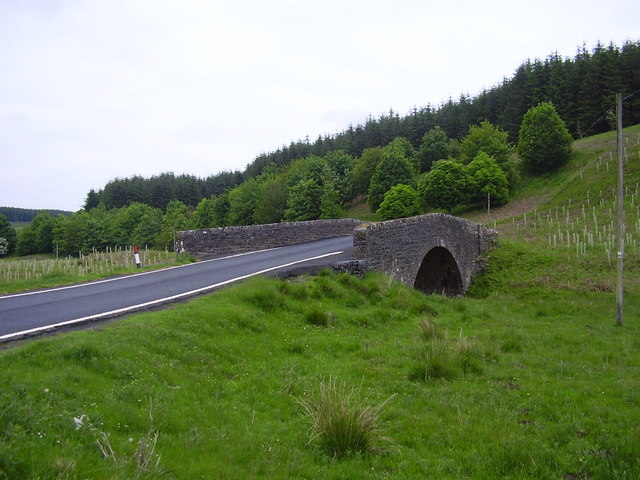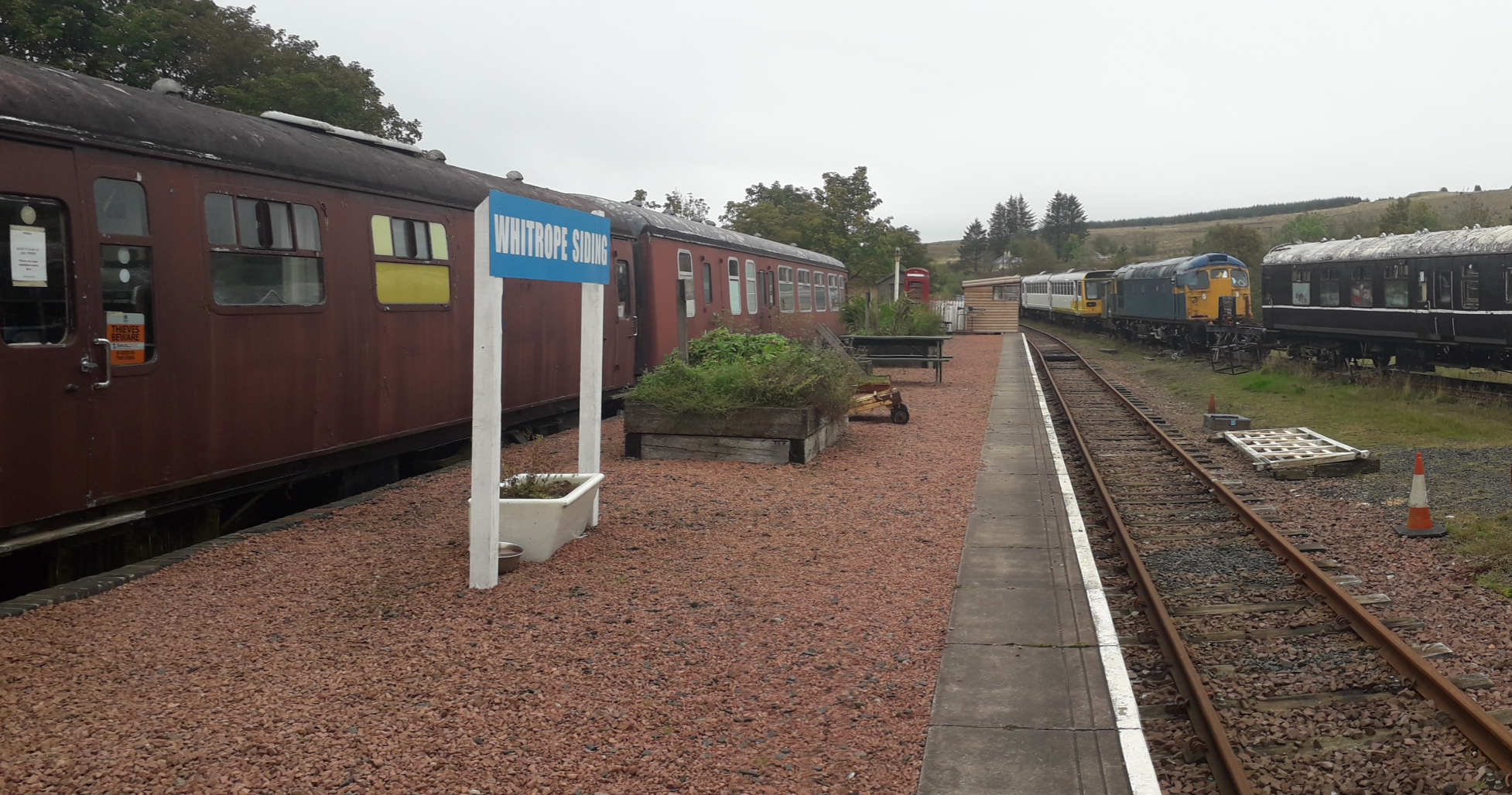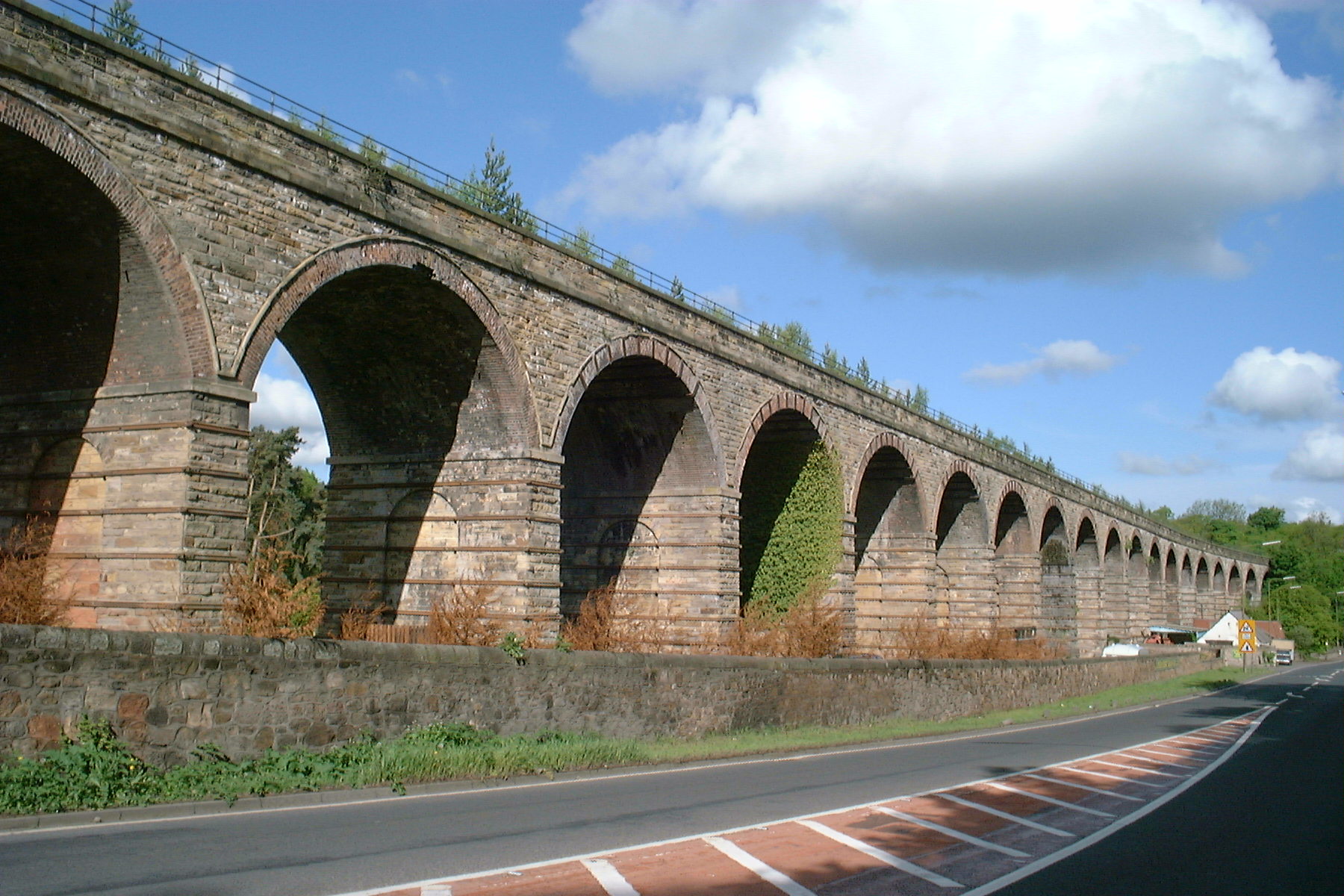|
Whitrope
Whitrope is a densely forested, but sparsely populated area, high in the Southern Upland hills in the south central Scottish Borders in the former county of Roxburghshire. Situated some 12 miles south from Hawick on the B6399 road, the Scottish watershed passes through the area; Whitrope Burn draining south towards Newcastleton and Flosh Burn draining north towards Hawick. The main features are the large forests managed by the Forestry Commission, and artefacts of Railway heritage. The Waverley Railway line passed over the whitrope summit in the Whitrope Tunnel at an elevation of . The Rail Heritage Centre is slightly south-west of this and is the headquarters of the Waverley Route Heritage Association. A length of track has been re-installed and there is a collection of rail rolling stock at the Whitrope Siding station. A network of Heritage Trails has been established, including the Ritson Trail, named after William Ritson, a contractor from the Victorian era, and responsi ... [...More Info...] [...Related Items...] OR: [Wikipedia] [Google] [Baidu] |
Whitrope Siding
Whitrope Siding was a trailing short siding or spur off the "up" (southbound) line, an associated trailing cross-over between up and down lines, a pair of railway cottages and a signal box on the Waverley Line or Waverley Route. It was used as a goods loading bay. The site is now the home of the Whitrope Heritage Centre, as well as the current terminus of the heritage Border Union Railway. The siding is located just south of the highest point on the line, the famous ''Whitrope Summit'', 1006 ft above sea level. It is approximately 300 metres south from Whitrope Tunnel, and 4 km north from Hermitage, Scottish Borders. Whitrope Heritage Centre Waverley Route Heritage Association maintains a small museum of old Waverley Route related artefacts and photographs within a static carriage (Mk2 BSO 9400) together with an adjoining buffet carriage (69316 from a 4BIG EMU). As of 2019, there is now a platform on the "down" side with over of track laid from the tunnel over th ... [...More Info...] [...Related Items...] OR: [Wikipedia] [Google] [Baidu] |
Waverley Line
The Waverley Route was a railway line that ran south from Edinburgh, through Midlothian and the Scottish Borders, to Carlisle. The line was built by the North British Railway; the stretch from Edinburgh to Hawick opened in 1849 and the remainder to Carlisle opened in 1862. The line was nicknamed after the immensely popular Waverley Novels, written by Sir Walter Scott. The line was closed in 1969, as a result of the Beeching Report. Part of the line, from Edinburgh to Tweedbank, reopened in September 2015. The reopened railway is known as the Borders Railway. History Origins Edinburgh and Dalkeith Railway The North British Railway (NBR) was established on 4 July 1844 when Parliamentary authorisation was given for the construction of a line from Edinburgh to Berwick-upon-Tweed with a branch to Haddington. The company's chairman and founder was John Learmonth, the chairman of the Edinburgh and Glasgow Railway, whose ambition it was to enclose the triangle of land between E ... [...More Info...] [...Related Items...] OR: [Wikipedia] [Google] [Baidu] |
Waverley Railway
The Waverley Route was a railway line that ran south from Edinburgh, through Midlothian and the Scottish Borders, to Carlisle. The line was built by the North British Railway; the stretch from Edinburgh to Hawick opened in 1849 and the remainder to Carlisle opened in 1862. The line was nicknamed after the immensely popular Waverley Novels, written by Sir Walter Scott. The line was closed in 1969, as a result of the Beeching Report. Part of the line, from Edinburgh to Tweedbank, reopened in September 2015. The reopened railway is known as the Borders Railway. History Origins Edinburgh and Dalkeith Railway The North British Railway (NBR) was established on 4 July 1844 when Parliamentary authorisation was given for the construction of a line from Edinburgh to Berwick-upon-Tweed with a branch to Haddington. The company's chairman and founder was John Learmonth, the chairman of the Edinburgh and Glasgow Railway, whose ambition it was to enclose the triangle of land between ... [...More Info...] [...Related Items...] OR: [Wikipedia] [Google] [Baidu] |
Whitrope Heritage Centre - Geograph
Whitrope is a densely forested, but sparsely populated area, high in the Southern Upland hills in the south central Scottish Borders in the former county of Roxburghshire. Situated some 12 miles south from Hawick on the B6399 road, the Scottish watershed passes through the area; Whitrope Burn draining south towards Newcastleton and Flosh Burn draining north towards Hawick. The main features are the large forests managed by the Forestry Commission, and artefacts of Railway heritage. The Waverley Railway line passed over the whitrope summit in the Whitrope Tunnel at an elevation of . The Rail Heritage Centre is slightly south-west of this and is the headquarters of the Waverley Route Heritage Association. A length of track has been re-installed and there is a collection of rail rolling stock at the Whitrope Siding station. A network of Heritage Trails has been established, including the Ritson Trail, named after William Ritson, a contractor from the Victorian era, and resp ... [...More Info...] [...Related Items...] OR: [Wikipedia] [Google] [Baidu] |
Whitrope Tunnel
The Whitrope Tunnel is a disused railway tunnel in the Scottish Borders, situated south of Hawick on the Waverley Route, close to Whitrope. It has a length of . It is the fourth longest tunnel in Scotland. The tunnel is on the Hawick to Carlisle part of the former line, opened in the 1860s by the North British Railway. The Tunnel was closed in 1969 (as with the Waverley Route itself) by British Rail. The Waverley Route Heritage Association is currently aiming to restore the tunnel to former standards and use. The tunnel is a Category B listed building and forms a key part of the former route. In March 2002 there was a partial collapse of the tunnel roof at the south portal, followed by a major collapse in March 2021. Although it is repairable, there is no source of funding and consequently the tunnel has been sealed off for public safety. See also *Whitrope Siding *List of places in the Scottish Borders *List of places in Scotland *List of tunnels in the United Kingdom ... [...More Info...] [...Related Items...] OR: [Wikipedia] [Google] [Baidu] |
Waverley Route Heritage Association
Waverley Route Heritage Association is a heritage railway group involved with the history, heritage and preservation of the Waverley Route, based/centred on Whitrope, south of Hawick, Scotland. Current projects include the restoration of the 1,208 yard Whitrope Tunnel, formerly part of the Border Union Railway. Also under restoration is Whitrope Siding, which is the headquarters of the line and the home of WRHA's ''Whitrope Heritage Centre''. The Association operates a train service along a mile of former Waverley Route track from Whitrope Tunnel to Bridge 200. The association's other aims include restoring most of the track south of Whitrope to Riccarton Junction. The WRHA have been negotiating a new lease with the Forestry Commission. Border Union Railway Company The Border Union Railway Company is a wholly owned subsidiary of the WRHA, which runs trains on a section of demonstration track north and south from Whitrope Heritage Centre. Motive power ;Diesel locomotive ... [...More Info...] [...Related Items...] OR: [Wikipedia] [Google] [Baidu] |
Riccarton Junction Railway Station
Riccarton Junction, in the county of Roxburghshire in the Scottish Borders, was a railway village and station. In its heyday it had 118 residents and its own school, post office and grocery store. The station was an interchange between the Border Counties Railway branch to Hexham and the North British Railway's (NBR's) Border Union Railway (also known as the Waverley Route). History The settlement of Riccarton, which adjoins the station, consisted, in 1959, of around thirty houses, with at least one member of each household working for British Railways, which had a civil engineer's depot near the station. Remarkably there was no road access until a forest track was built in 1963, all access until then being by rail. The isolated position of Riccarton and the need to provide for the villagers may have been one reason why the station remained open until the late 1960s, as by this time ordinary public traffic was virtually non-existent. The branch line from Riccarton Junction to ... [...More Info...] [...Related Items...] OR: [Wikipedia] [Google] [Baidu] |
List Of Places In The Scottish Borders
''Map of places in the Scottish Borders compiled from this list'':See the list of places in Scotland for places in other counties. This list of places in the Scottish Borders includes towns, villages, hamlets, castles, golf courses, historic houses, hillforts, lighthouses, nature reserves, reservoirs, rivers, and other places of interest in the Scottish Borders council area of Scotland. A * Abbey Mill * Abbey St. Bathans *Abbotsford Ferry railway station, Abbotsford House *Abbotrule *Addinston * Aikwood Tower *Ale Water *Alemoor Loch *Allanbank * Allanshaugh * Allanshaws * Allanton *Ancrum, Ancrum Old Parish Church *Anglo-Scottish Border * Appletreehall *Ashiestiel *Ashkirk * Auchencrow * Ayton, Ayton Castle, Ayton Parish Church, Ayton railway station B *Baddinsgill, Baddinsgill Reservoir *Bairnkine * Bassendean * Battle of Ancrum Moor * Battle of Humbleton Hill * Battle of Nesbit Moor (1355) *Battle of Nesbit Moor (1402) *Battle of Philiphaugh ... [...More Info...] [...Related Items...] OR: [Wikipedia] [Google] [Baidu] |
Shankend Viaduct
Shankend Viaduct is a former railway viaduct in the Scottish Borders just over six miles south of the town of Hawick. It is a category B listed building. It carried the Edinburgh-Carlisle main line of the North British Railway, the Waverley Line, on 15 stone arches across the shallow Langside valley and the Langside burn. It has a maximum height of and has been extensively repaired with brick patching. The viaduct was the last section of the Waverley Line and was opened to goods traffic on 28 June 1862 and passenger traffic on 1 July 1862. The contract for the construction of the viaduct was awarded together with the nearby southern Whitrope Tunnel on the same line. With the closure of the entire route on 6 January 1969, the viaduct became obsolete and the rails have since been removed. In the 2000s, the monument was extensively restored by BRB (Residuary) Limited. After the successful re-opening of some of the former Waverley Line between Edinburgh and , there have been c ... [...More Info...] [...Related Items...] OR: [Wikipedia] [Google] [Baidu] |
Liddesdale
Liddesdale, the valley of the Liddel Water, in the Roxburghshire, County of Roxburgh, southern Scotland, extends in a south-westerly direction from the vicinity of Peel Fell to the River Esk, Dumfries and Galloway, River Esk, a distance of . The Waverley Line, Waverley route of the North British Railway runs down the dale, and the Catrail, or Picts' Dyke, crosses its head. Liddesdale was also a historic district of Scotland, bordering Teviotdale to the east, Annandale, Dumfries and Galloway, Annandale to the west and Tweeddale to the north, with the England, English county of Cumberland across the border to the south. The area was in the Sheriffdom of Roxburgh and later became part of the Roxburghshire, County of Roxburgh, one of the counties of Scotland. The main reorganisation took place during the Local Government (Scotland) Act 1889, this Act established a uniform system of county councils and town councils in Scotland and restructured many of Scotland's counties. (See: Histor ... [...More Info...] [...Related Items...] OR: [Wikipedia] [Google] [Baidu] |
The B6399 Crosses The Whitrope Burn - Geograph
''The'' () is a grammatical article in English, denoting persons or things that are already or about to be mentioned, under discussion, implied or otherwise presumed familiar to listeners, readers, or speakers. It is the definite article in English. ''The'' is the most frequently used word in the English language; studies and analyses of texts have found it to account for seven percent of all printed English-language words. It is derived from gendered articles in Old English which combined in Middle English and now has a single form used with nouns of any gender. The word can be used with both singular and plural nouns, and with a noun that starts with any letter. This is different from many other languages, which have different forms of the definite article for different genders or numbers. Pronunciation In most dialects, "the" is pronounced as (with the voiced dental fricative followed by a schwa) when followed by a consonant sound, and as (homophone of the archaic ... [...More Info...] [...Related Items...] OR: [Wikipedia] [Google] [Baidu] |
Forestry Commission
The Forestry Commission is a non-ministerial government department responsible for the management of publicly owned forests and the regulation of both public and private forestry in England. The Forestry Commission was previously also responsible for Forestry in Wales and Scotland. However, on 1 April 2013, Forestry Commission Wales merged with other agencies to become Natural Resources Wales, whilst two new bodies (Forestry and Land Scotland and Scottish Forestry) were established in Scotland on 1 April 2019. The Forestry Commission was established in 1919 to expand Britain's forests and woodland, which had been severely depleted during the First World War. The Commission bought large amounts of agricultural land on behalf of the state, eventually becoming the largest manager of land in Britain. Today, the Forestry Commission is divided into three divisions: Forestry England, Forestry Commission and Forest Research. Over time the purpose of the Commission broadened to includ ... [...More Info...] [...Related Items...] OR: [Wikipedia] [Google] [Baidu] |







.png)
